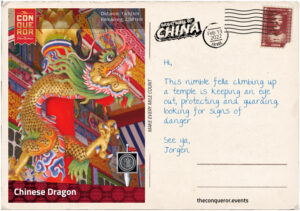Tre timmar efter avklarat 40%, kom även vykort nummer 19.
I det här tempot kommer vi att vara klara innan sommaren!

Nittonde vykortet
Remember Laolongtou, Old Dragon Head, at the beginning of this journey? He was drinking from the sea whilst the rest of his serpentine body, aka the Great Wall, contoured over the lofty mountain peaks and across valleys in a constant up and down motion. I am still searching for the tail.
The Chinese dragon is a legendary creature that is often associated with wealth, power and leadership. They are seen as noble and wise, exuding a good dose of luck and are often depicted breathing clouds instead of fire. It has control over watery phenomenon and is usually pictured floating in the sky, chasing flaming pearls, a treasured possession, that are said to multiply or enlarge anything that they come into contact with.
For a time during ancient China, only emperors were permitted to have items with dragon images on them. The dragon robe was an everyday garment used by royalty since the 7th century. It was a circular-collared robe embellished with dragons to symbolize imperial power. Over time, the cuts of the robes were modified to suit the ruling dynasty but the embroidered dragons were ever-present.
Chinese dragons are usually illustrated as having long, snake-like bodies and sharp, hawk-like claws. However, they can at times be rendered as other shapes such as dragon turtles. With the body of a turtle and the head of a dragon, the creature is typically associated with feng shui, symbolizing courage, longevity, success and more.
Dating back to 206BC, the Dragon Dance is the highlight of many festivities, especially Chinese New Year and the Lantern Festival. The dragon, up to 230ft (70m) long, is made of bamboo hoops covered with fabric and held by dancers. The dragon is moved in all directions, dancing to the sound of pounding drums. They are wonderfully colourful spectacles.
The Dragon Boat Festival is another important event that has the status of being included in the UNESCO Intangible Cultural Heritage list. The event commemorates the ancient poet, Qu Yuan, who drowned himself as a “gesture of dying along with his motherland” when his home state was invaded. The boat is shaped in the form of a Chinese dragon and the team paddles harmoniously to the sound of beating drums. The winning team is said to have good luck and a happy life in the following year.
Chinese dragons permeate everywhere, from architecture to textiles, artwork to ceramics, metalwork, jewellery, festivals, astrology and idioms. China is home to the most places named after dragons in the world.